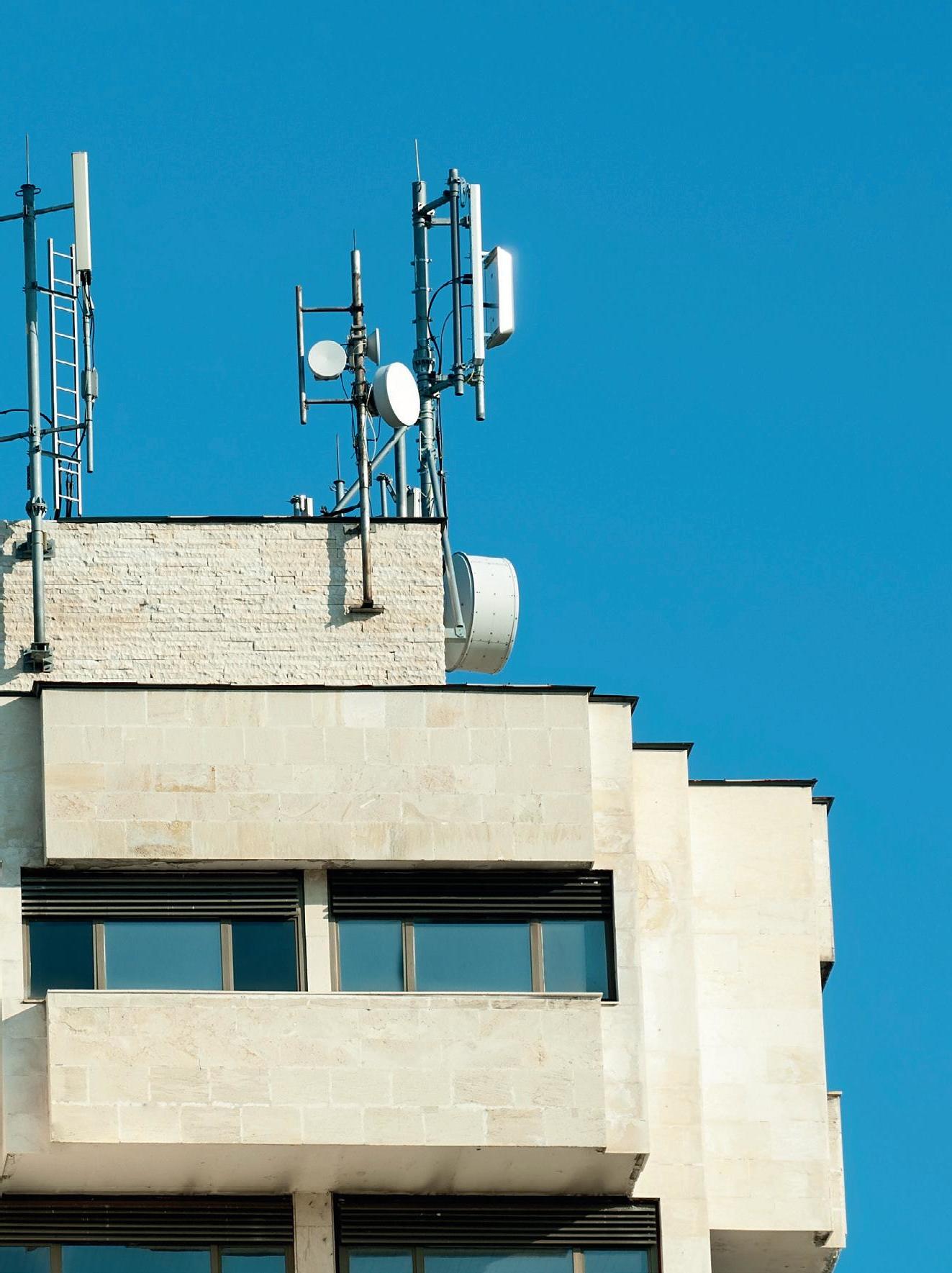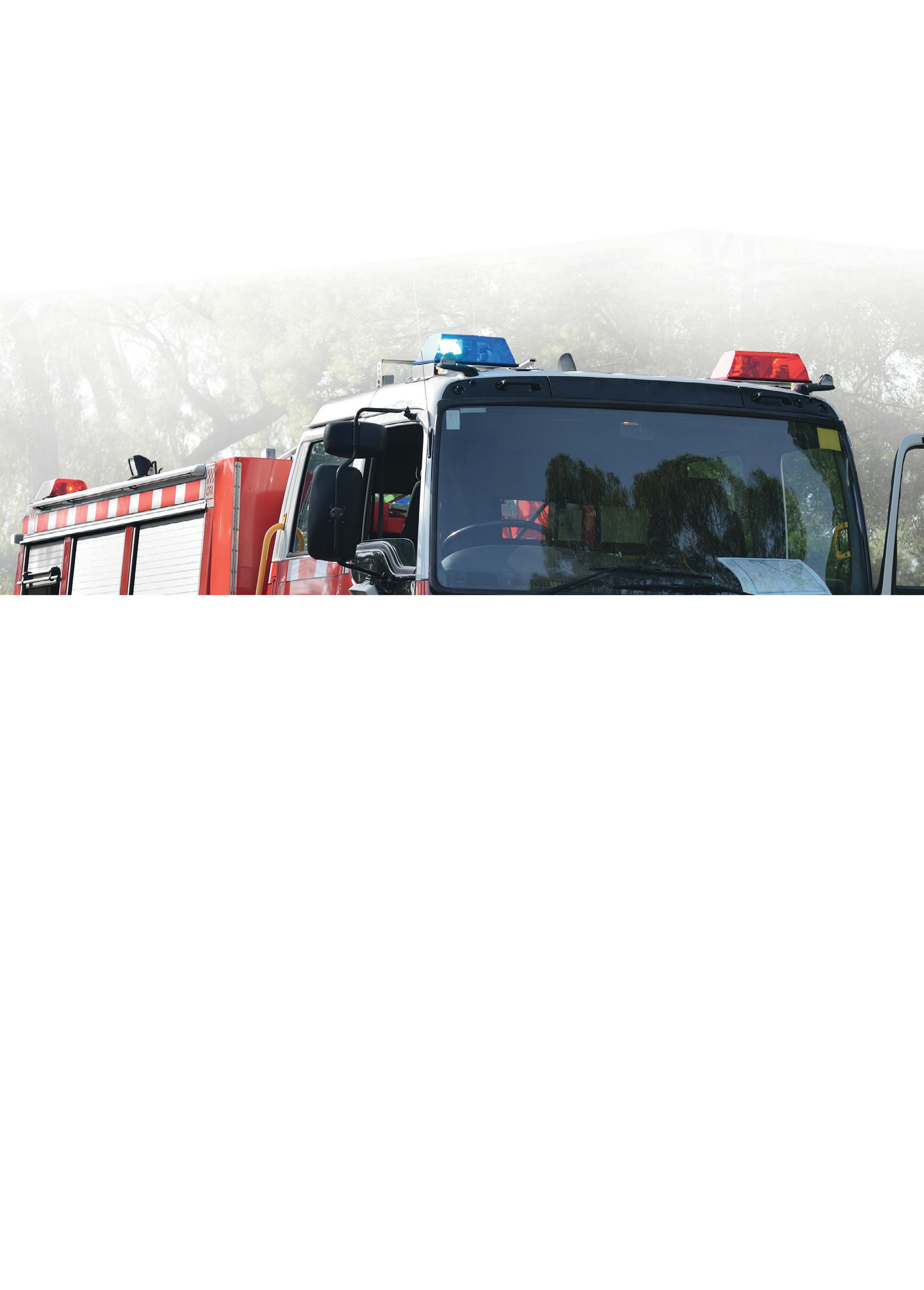
11 minute read
Worker safety near radio transmitters
Tony Paul
An understanding of RF hazards and associated safe work practices is essential for anyone who works on or near radio transmitters.
The radio connections upon which we rely for safety and security, business and personal communications and entertainment, are most effectively delivered to devices from a significant height above the surrounding area. This means that towers and rooftops, power poles and other existing buildings and structures are the best locations for transmitters and antennas.
Radio waves used to carry digital information to and from a mobile device do so at low power levels that improve the efficiency of data transmission by reducing radio interference. Transmitters are located in the environment to provide the required communications to a specific coverage area. As a result, workers in many occupations may encounter radio transmission antennas in their work at heights, either at a transmitter site or adjacent to it, including: • Building maintenance — window cleaning, signage, rigging • Mechanical maintenance — heating, ventilation and air-conditioning systems • Construction work — cranes, scaffolding and rigging • Tree maintenance • Energy network maintenance — eg, powerlines • Street lighting and traffic sign maintenance • Emergency services attending incidents such as fires and storm damage.
Safe work standards Safe work near any hazard is typically defined by three key pillars of control: • Safety standards set the limits for exposure • Workplace legislation sets the management requirements

• Employers ensure workers are aware and equipped to manage work near these hazards.
The International Commission for NonIonizing Radiation Protection (ICNIRP) has developed guidelines for protection of people from exposure to radio frequency (RF) radiation. The Australian regulator, ARPANSA, mirrors the ICNIRP guideline in its Radiation Protection Series Standard, RPS 3, which sets out safe exposure levels for all radio services in Australia. Generally, the levels of exposure on the ground from most radio services are many thousands of times below the human exposure limits set by the RPS 3 standard. However, these human exposure limits can be encountered by workers when they are close to the radiating antennas usually within 50 metres directly in front of the antenna.
©stock.adobe.com/au/Deyan Georgiev
ICNIRP has recently updated the guideline to provide clearer guidance on the practical application of exposure limits and the inclusion of 5G technology in higher frequency ranges. ARPANSA is undertaking a review of these changes and will include the ICNIRP improvements in its updated RPS 3 standard later in 2020.
Work health and safety legislation The federal and state work health safety (WHS) Acts require an employer to actively manage all hazards in the employee’s work spaces, and this includes RF radiation for workers at height. In order for this to be achieved, it is very important that there is a strong awareness of radio sources and how to work near them.
Employers are responsible for identifying all hazards that may affect a worker’s activity and for putting controls in place to eliminate or manage risks through the documentation and implementation of safe work methods.
How do I keep myself and my workers safe? The typical WHS hierarchy of controls prioritises the elimination of hazards. This can be most effectively achieved by identifying the areas that should not be accessed, known as the ‘RF Hazard boundary’. The common ways to achieve this are through awareness and familiarity with the types of radio antennas that are commonly used and the ways to identify the owner and operator of that service.
As with any workplace hazard, planning is key in defining hazards and developing Safe Work Methods Statements (SWMS) for workers to follow. The key elements of workplace hazard planning are: • Risk assessment and awareness • Training • Resources • Personal protection equipment
At the time of writing it is noted that a number of state-based safety agencies did not have specific statements on safe work with RF radiation. However, SafeWork NSW has recognised that the WHS Acts are silent on this specific hazard and is considering the addition of some information to its hazard library.
Training Radiofrequency awareness training is available from a number of registered training organisations, and many of these courses are available online. The mobile telecommunications industry recognises courses that are accredited by the Australian Centre for Electromagnetic Bioeffects Research (ACEBR) to ensure that workers are equipped with sufficient knowledge to keep themselves safe. While this accreditation is not mandatory for all workers, it is advisable to seek some independent advice on the training available.
Identification of the antenna owner WHS legislation requires that businesses must do everything that is reasonable and practical to ensure the health and safety of workers and others. Businesses and employers must prioritise the elimination of any health and safety risks in the workplace so far as is ‘reasonably practicable’.
Key to this requirement is the identification of antennas in close proximity to a workplace.
Mobile base station sites The Mobile Carriers Forum (MCF), a division of the Australian Mobile Telecommunications Association (AMTA), has developed the AMTA-branded ‘RF Safety Program’ to undertake compliance and safety assessments of all mobile phone base station installations nationally. The program uses a national database for site details, settings and site safety documentation. The AMTA RFNSA database is a great place to start if you need to determine whether there is a mobile base station near your work area. It is available via the MobileSiteSafety.com. au website and mobile app, and shows you on a map where the sites are and who to contact for assistance with access to or near the site.
The facility manager of the base station site should be able to provide you with a copy of the EME Guide, which includes Safe Work information and drawings showing the extent of the controlled hazard areas around the site. The carriers that use the site are also contactable for assistance. Other radio transmitters Many towers and buildings host a number of radio services along with mobile base stations and the carriers will include these services in the EME Guide where information is made available. If the antennas are not in an EME Guide for the site or are not shown in MobileSiteSafety app, then the ACMA Register of Radio Licences (RRL) can be used to assist in identifying the services present at a site. The ACMA RRL database can be searched by street address and all registered licences can be identified on an interactive map (see https://web.acma.gov. au/rrl/register_search.main_page).
RadioWorkSafe app The key to avoiding exposure when working near an RF hazard is an understanding of the steps involved for development of a Safe Work Method Statement. AMTA has recognised that this may be daunting to many employers and workers and has developed the RadioWorkSafe App to assist employers and workers.
The MobileSiteSafety.com.au website and mobile app shows you where transmitter sites are and who to contact for assistance.
RadioWorkSafe is AMTA’s flagship RF safety educational initiative, providing the basic safety steps for working on base stations, buildings and other facilities with radio transmitting antennas. RadioWorkSafe also provides a simple approach to RF safety education.
The features available to all workers free of charge through RadioWorkSafe.com.au include: • Basic safety steps • A Safe Work checklist • Training videos • Fact sheets • Information resources • Site contacts • Safety bookmark


Personal RF monitors Personal RF monitors are available for workers who regularly need to need to approach RF exclusion zones. As these devices can cost up to $3000 per unit and require calibration at two-year intervals, they are highly specialised equipment and not recommended for occasional work near RF sources.
What about 5G? 5G networks are designed to work in conjunction with 4G networks using a range of macro cells, small cells and dedicated in-building systems. Small cells will be a feature of 5G networks and will evolve to include the use of millimetre-wave frequencies. Small cells are mini base stations designed for very localised coverage, typically from 10 metres to a few hundred metres and providing in-fill for the larger macro network. Small cells will be essential for the 5G networks.
Is 5G safe? This is an important question. In January 2020, Australia’s Chief Medical Officer, Professor Brendan Murphy, issued the following statement to reassure Australians:
I’d like to reassure the community that 5G technology is safe. There is no evidence telecommunication technologies, such as 5G, cause adverse health impacts. This position is supported by health authorities in Australia — such as the Australian Radiation Protection and Nuclear Safety Agency (ARPANSA) — and around the world, such as the World Health Organization (WHO).
Telstra conducted measurements on its 5G network in 2019 and concluded that “5G EME levels were found to be well below the safety limit, and in many cases over a thousand times lower”. However, from a safe work perspective, 5G services should be treated the same as other radio services and the recommended safe work procedures for RF hazards are also applicable.
Tony Paul is Principal at PicoNet Consulting and fulfils the role of RF Safety Program Manager for AMTA.









News
EE, NOKIA TO TRIAL 4G LTE AIR NETWORK EE has signed an agreement with Nokia to build a nationwide 4G LTE air-to-ground network for the UK’s Emergency Services Network. The network is expected to provide uninterrupted, high-speed broadband coverage for emergency service personnel working above ground from 500 feet up to 10,000 feet. It will provide connect people, sensors, aircraft and helicopters. As part of the agreement, EE will provide the active network equipment for a full reference facility and an initial seven-site trial network. Following the trial, EE will deploy the network equipment in more than 80 Home Office-acquired cell sites across the UK. Nokia will provide design support, network equipment, installation and commissioning services. More info: bit.ly/2VbN7X2


©stock.adobe.com/au/visoot
NEW GRN SITE GOES LIVE ON CENTRAL COAST The NSW Telco Authority continues to expand the government radio network (GRN), with a new site activated at Wyong Creek on the NSW Central Coast. The GRN is the narrowband public safety radio network used by the state’s emergency services and other government agencies. “Radio sites, including this new site in Wyong Creek, provide emergency services organisations with a single, integrated network on which to communicate,” said NSW Telco Authority Managing Director Kylie De Courteney. “By expanding the footprint of this critical infrastructure, we are ensuring that frontline responders have an enhanced and more reliable radio network to help keep people and places safe.” More info: bit.ly/3eBkrhS DC power systems Helios Power Solutions’ DC power product range includes over 500 standard products and more than 2000 custommade designs, including: battery-backed power systems for communications huts, inverter charger systems, battery chargers for industrial applications, battery racks and customised form factor designs to fit into existing installations.
Helios’ DC systems are designed, integrated and manufactured in Australia and New Zealand, and can be customised to suit any application, with options including: IP-rated and portable solutions, labelling, special terminations/connections, remote monitoring and control, N+X redundancy level, mounting and form factor, status signals and control, voltage adjustment (knob/pot), special input and multioutput options, and conformal coating.
Helios Power Solutions
www.heliosps.com.au
Portable power solution The Acumentrics Carry-On Power Case, available from Metromatics, is a rugged, ready-to-integrate portable system with built-in power and data communications capability. The large available volume allows for storage and operation of critical equipment in the absence of grid or vehicle power. Both 100 and 300 W versions are equipped with AC inputs/ outputs, DC inputs/outputs and USB ports. Key features include global auto-ranging power inputs, FAA compliance and IP67 water/dust resistance.
Metromatics Pty Ltd
www.metromatics.com.au

Portable radios The Kenwood NX-1000 series portable radios offer the choice between NXDN or DMR protocols, with automatic digital/analog mixed-mode operation. DMR or NXDN digital versions are available. The radios feature an 8-digit white backlit LCD, a large seven-colour LED indicator on the top panel, RF output power of 5 W on both VHF and UHF, TX/RX audio profile with optimisable digital processor with VOX and PTT (triggered semi-VOX and voice-operated TX) and a customisable emergency profile. Other features include DMR Auto Slot Select, Dual Slot Direct Mode, Over-the-Air Alias, lone worker and remote stun/kill/check. The units are IP67 rated and conform to MIL-STD-810 C/D/E/F/G.
JVCKENWOOD Australia Pty Ltd
www.kenwood.com.au















